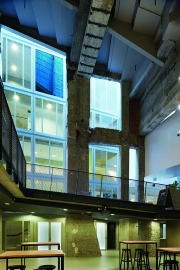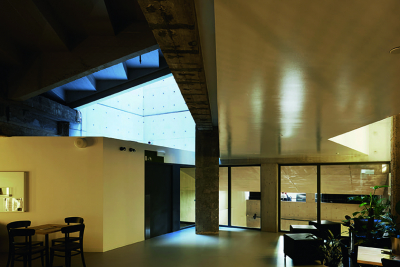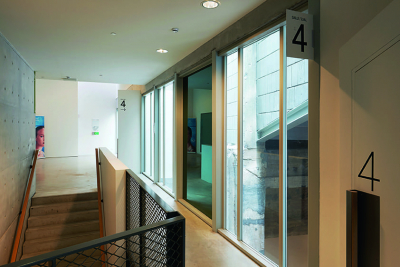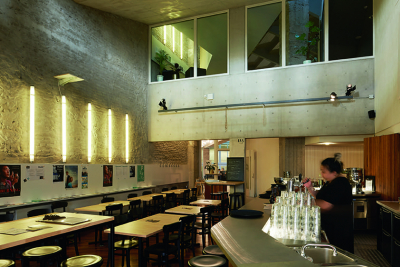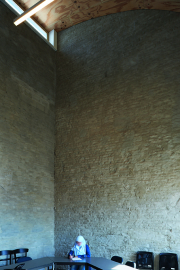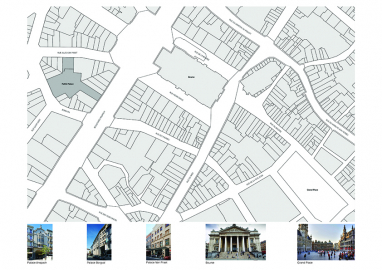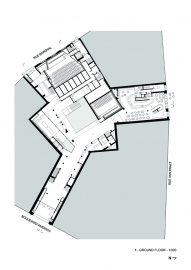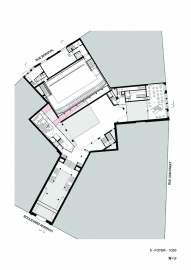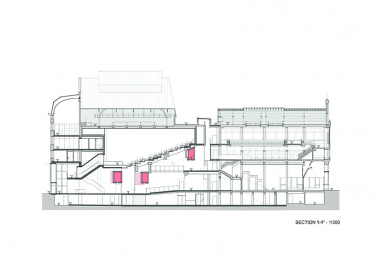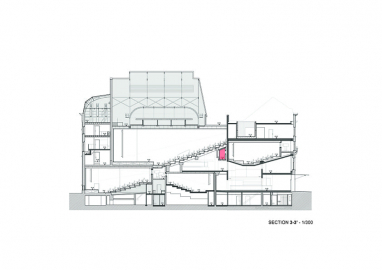Rehabilitation of the ancient Pathé Palace to a cinema and a cultural complex
In the heart of Brussels, the complete renovation of the former Pathé Palace has created a multicultural exchange centre. The centre consists of a cinema complex of four screens, primarily dedicated to art house films, with a pedagogical section and a variety of event activities.
Born a year before the character of Charlot, and thanks to the determination of Charles Pathé - the client - and the talent of Paul Hamesse – the architect -, the Pathé Palace has seen a century of cinematographic creations. Intensely transformed in 1950 to become a full cinema and then again in 1999, when it became a "miniplex", the building finally reached a stage where people lost all ability to make sense of it, especially because of all the partitions added over time.
By intervening in this pre-existing context, the project is part of a continuum: the permanent action of man for the development of its existence. This project was the opportunity to settle in a place that was a flagship of Art Nouveau. Paradoxically, it is because the original complex was largely destroyed that we could project the current program among the different layers of its history which were still available to be seen.
Nowadays, three distinct entrances connect the three vibrant atmospheres of the surroundings and allow to stroll freely through all the building public spaces: the four levels foyer, the large brasserie, the bar in the basement, the event hall, the access to the programming level, and the workplaces and meeting spaces on offer. The management area, the administration space and the reception centre remain discreet.
A multifaceted foyer gives access to the screens and, in the same time, invites people to socialize in different areas.
The four screens have a high visual level and acoustic comfort.
The Pathé Palace is the unveiling of a historic site that tells a century of Brussels' history through a century of cinema.
This project was one of managing complexity and taking into account a large number of constraints without losing track of its purpose and relevance.
The urban context, the multiple programmatic aspects, the traffic flow, the morphology of the property, the heritage elements, safety and security, and the building accessibility to all: nothing was simple in this project.
Creating space, by disassembling and thoughtfully evacuating elements, allowed the introduction of natural light into the complex, as well as revealed and highlighted the value of the preserved elements.
The foyer took full advantage of the additional open space to become a multifunctional place enabling multicultural exchanges. The open space allows for the unrestricted flow of ideas, thoughts and people.
The foyer, grew to become the hub of the building, brought to life by the different spaces’ atmospheres (bar, shop, kiosk) from the basement to the upper levels which gives access to the screens.
Connecting seven floors, a glass tower manage vertical traffic and access to the screens. It became the boarding area that leads spectators to the adventure of the movies, via the screens entrance tunnels.
Before building in this space, we first cleared away the superfluous, thus its history has been revealed.
On Anspach Blvd, the entrance is still covered with a frame of 1881. Inside, the delicate mesh of concrete beams and columns (1913) as well as the powerful structure of the balcony of 1950 have been preserved.
The project shows each of these elements that have made the soul of the Palace and seeks above all to let the story be told. New interventions are autonomous objects that add value and life to the pre-existing and pre-structured space.
For the distribution tower, a thin colonnade (steel tubes filled with concrete) supports the slabs. It is covered with a glass skin.
Linking the distribution tower to the screen rooms, the tunnels are made of steel frames, covered with plasterboard.
Each level of the foyer houses a unique object: the basement bar in galvanised steel, the ticket office in pine wood, the kiosk in painted panels.
The dialogue of the concrete from different eras is enriched with new elements made of smooth concrete.
Entirely sandwiched between party walls, the Palace compensates for the thermal weakness of its listed façades by isolating its floors and roofs.

